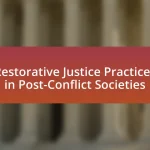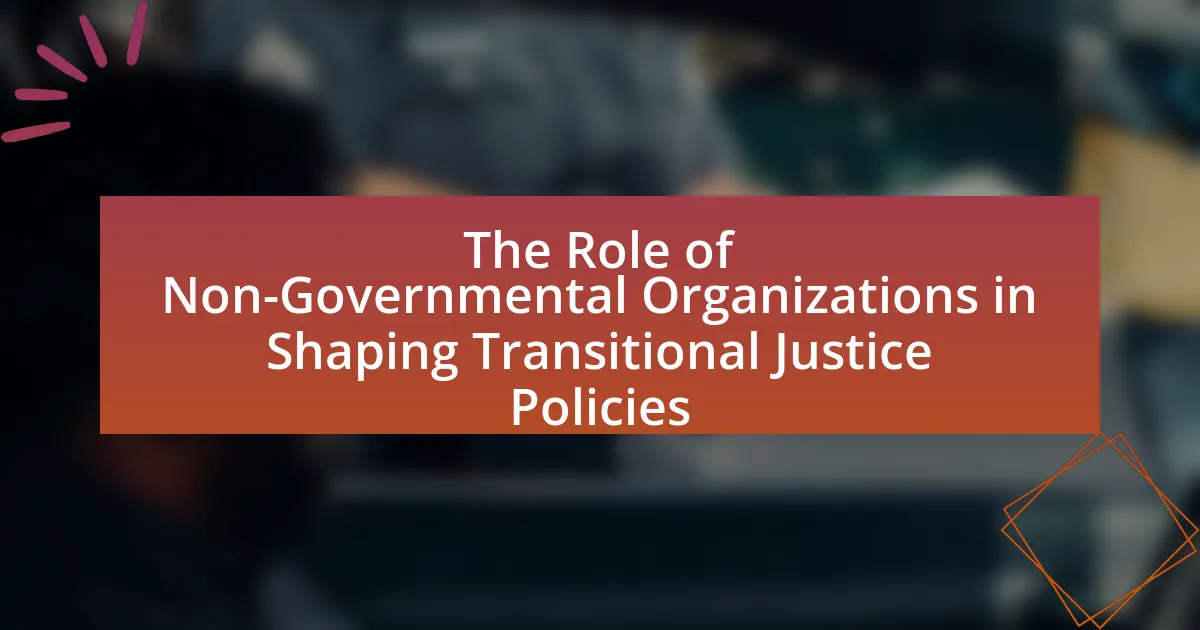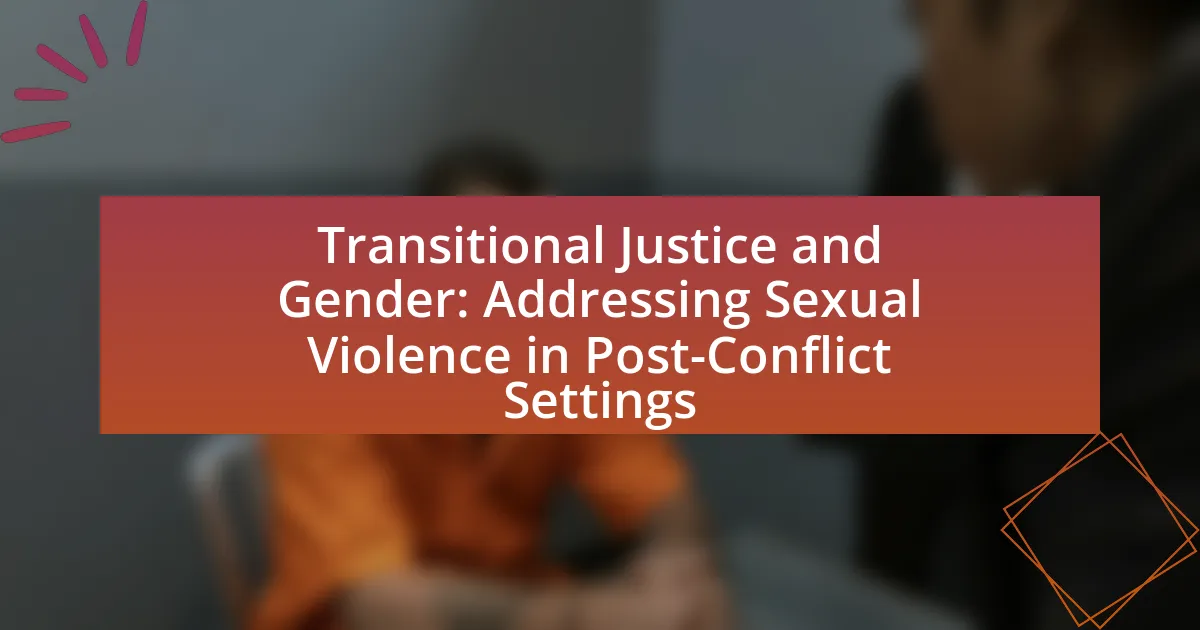The article focuses on the comparative analysis of transitional justice models in post-conflict societies, examining frameworks designed to address the aftermath of conflict and human rights violations. It outlines various models, including truth commissions, criminal prosecutions, reparations, and institutional reforms, highlighting their key components and how they differ across contexts. The article also discusses the influence of cultural factors on the effectiveness of these models, the importance of comparative analysis in identifying best practices, and the social and economic impacts of implementing transitional justice. Additionally, it addresses the challenges faced in practice, including political resistance and societal divisions, while suggesting practical steps for enhancing stakeholder engagement and the overall effectiveness of transitional justice initiatives.
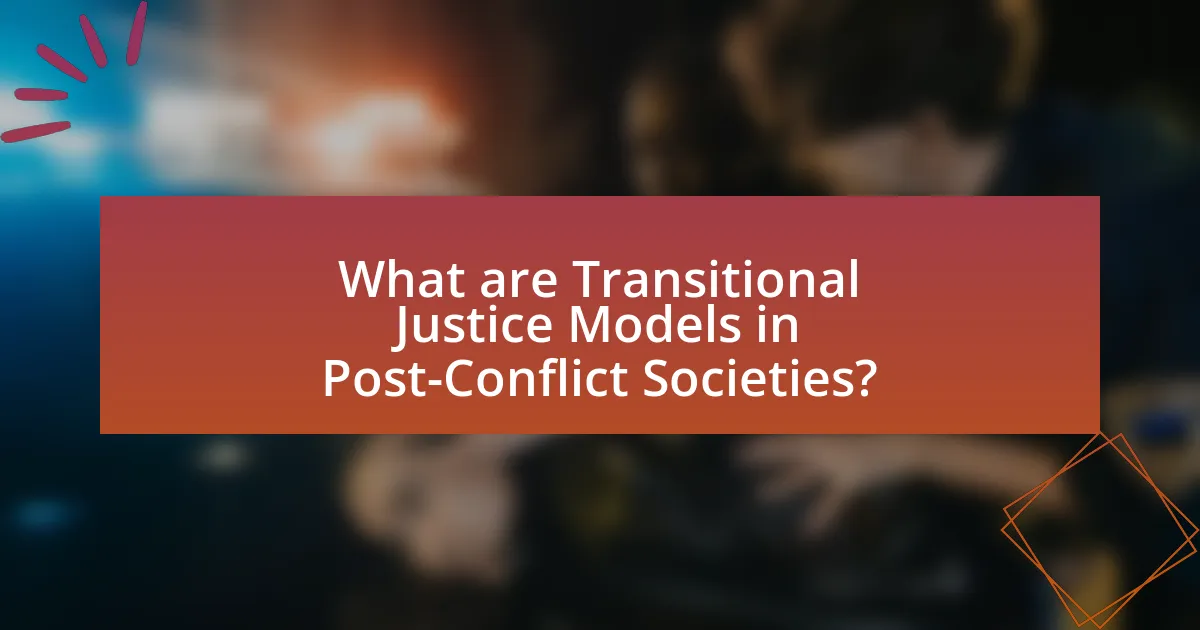
What are Transitional Justice Models in Post-Conflict Societies?
Transitional justice models in post-conflict societies are frameworks designed to address the aftermath of conflict and human rights violations, aiming to promote accountability, reconciliation, and the rule of law. These models typically include mechanisms such as truth commissions, criminal prosecutions, reparations, and institutional reforms, which collectively seek to acknowledge past abuses, provide justice to victims, and prevent future violations. For instance, the Truth and Reconciliation Commission in South Africa is a prominent example that facilitated dialogue and healing after apartheid, demonstrating the effectiveness of transitional justice in fostering societal healing and rebuilding trust.
How do Transitional Justice Models differ across various contexts?
Transitional Justice Models differ across various contexts primarily due to the specific historical, cultural, and political circumstances of each society. For instance, in South Africa, the Truth and Reconciliation Commission was established to address apartheid-era injustices through restorative justice, emphasizing dialogue and forgiveness. In contrast, in Rwanda, following the 1994 genocide, the Gacaca courts focused on community-based justice and accountability, reflecting the need for rapid reconciliation and local involvement. These models illustrate how transitional justice adapts to the unique needs and challenges of different societies, such as the level of violence experienced, the existing legal frameworks, and the societal desire for either retribution or reconciliation.
What are the key components of different Transitional Justice Models?
The key components of different Transitional Justice Models include truth-seeking mechanisms, accountability processes, reparations, and institutional reforms. Truth-seeking mechanisms, such as truth commissions, aim to uncover the facts about past human rights violations, as seen in South Africa’s Truth and Reconciliation Commission. Accountability processes involve legal actions against perpetrators, exemplified by the International Criminal Court’s prosecutions. Reparations provide compensation to victims, which can be financial or symbolic, as demonstrated in various Latin American countries. Lastly, institutional reforms focus on restructuring state institutions to prevent future abuses, a critical aspect in countries like Rwanda post-genocide. These components collectively address the legacies of conflict and aim to foster reconciliation and stability in post-conflict societies.
How do cultural factors influence the effectiveness of these models?
Cultural factors significantly influence the effectiveness of transitional justice models in post-conflict societies by shaping community perceptions, values, and expectations regarding justice and reconciliation. For instance, in societies where collectivist values prevail, community-based approaches to justice, such as restorative justice, may be more effective than punitive measures, as they align with cultural norms emphasizing communal harmony and collective healing. Research by the International Center for Transitional Justice highlights that in societies like South Africa, cultural narratives around forgiveness and reconciliation played a crucial role in the success of the Truth and Reconciliation Commission. This demonstrates that understanding and integrating local cultural contexts into transitional justice processes can enhance their legitimacy and acceptance, ultimately leading to more successful outcomes in post-conflict settings.
Why is Comparative Analysis important in studying Transitional Justice Models?
Comparative analysis is important in studying transitional justice models because it allows researchers and policymakers to identify effective practices and outcomes across different contexts. By examining various transitional justice mechanisms, such as truth commissions, reparations, and trials, scholars can assess which approaches have successfully addressed past injustices and promoted reconciliation. For instance, the comparative study of South Africa’s Truth and Reconciliation Commission and Argentina’s trials for human rights violations reveals differing impacts on societal healing and accountability. This analysis provides valuable insights into the conditions that foster successful transitional justice initiatives, thereby informing future implementations in post-conflict societies.
What insights can be gained from comparing different models?
Comparing different models of transitional justice in post-conflict societies reveals critical insights into their effectiveness, adaptability, and societal impact. Such comparisons allow researchers and policymakers to identify best practices, understand the contextual factors that influence outcomes, and assess the strengths and weaknesses of each model. For instance, studies have shown that restorative justice models often foster reconciliation more effectively than retributive justice models, as evidenced by the success of truth commissions in countries like South Africa and Sierra Leone. This comparative analysis not only highlights the importance of tailoring justice mechanisms to specific cultural and historical contexts but also informs future interventions aimed at achieving sustainable peace and justice.
How does Comparative Analysis contribute to best practices in Transitional Justice?
Comparative Analysis contributes to best practices in Transitional Justice by enabling the identification of effective strategies and lessons learned from various contexts. By examining different transitional justice models, such as truth commissions in South Africa and reparations programs in Argentina, practitioners can discern which approaches yield positive outcomes in terms of reconciliation, accountability, and societal healing. For instance, research indicates that the South African Truth and Reconciliation Commission successfully facilitated dialogue and acknowledgment of past atrocities, which can serve as a model for similar initiatives in other post-conflict societies. This analytical framework allows policymakers to adapt successful elements to their unique circumstances, thereby enhancing the overall effectiveness of transitional justice efforts.
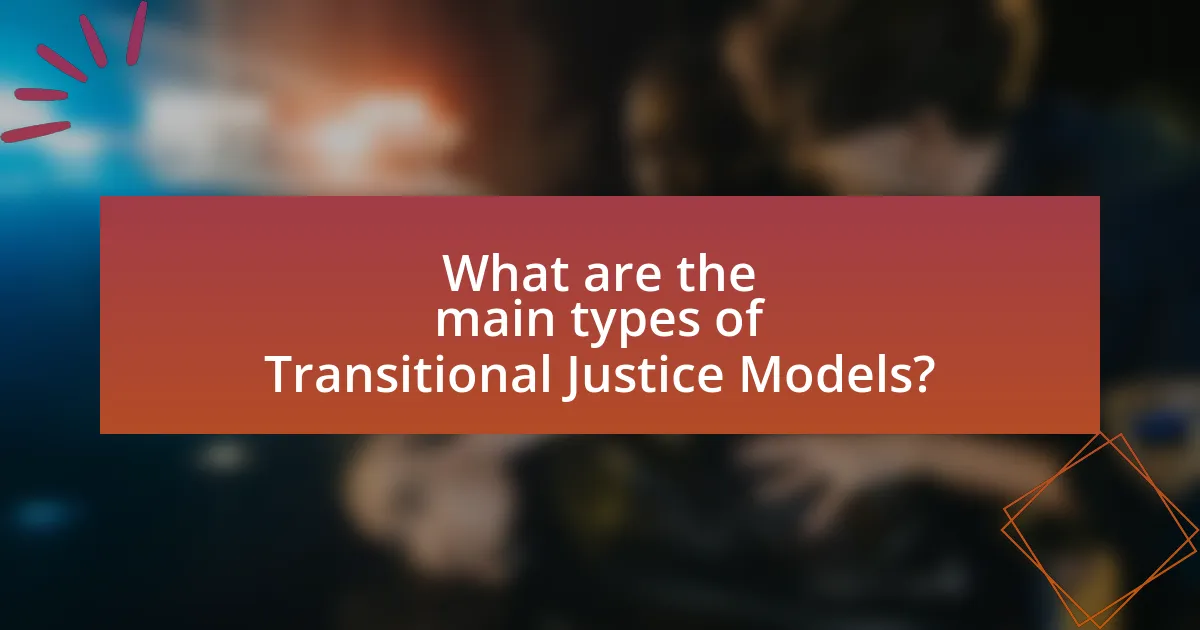
What are the main types of Transitional Justice Models?
The main types of Transitional Justice Models include retributive justice, restorative justice, and reparative justice. Retributive justice focuses on punishing perpetrators of human rights violations, often through legal trials, as seen in the Nuremberg Trials post-World War II. Restorative justice emphasizes healing and reconciliation between victims and offenders, exemplified by South Africa’s Truth and Reconciliation Commission, which aimed to foster national unity after apartheid. Reparative justice involves compensating victims for their suffering, which can include financial restitution or acknowledgment of harm, as practiced in various countries following conflicts. Each model serves distinct purposes in addressing past injustices and promoting societal healing.
What are the characteristics of Restorative Justice Models?
Restorative Justice Models are characterized by their focus on repairing harm, fostering dialogue, and involving all stakeholders in the justice process. These models prioritize the needs of victims, encourage accountability from offenders, and promote community involvement in resolving conflicts. Evidence shows that restorative justice can lead to higher victim satisfaction rates and lower recidivism compared to traditional punitive systems, as highlighted in studies such as the meta-analysis by Bradshaw and Roseborough (2005), which found that restorative practices significantly improve outcomes for both victims and offenders.
How do Restorative Justice Models promote healing in post-conflict societies?
Restorative Justice Models promote healing in post-conflict societies by facilitating dialogue and reconciliation between victims and offenders. These models prioritize the needs of victims, allowing them to express their experiences and emotions, which fosters a sense of validation and acknowledgment. For instance, in South Africa’s Truth and Reconciliation Commission, victims shared their stories, contributing to collective healing and societal understanding of past atrocities. Additionally, restorative justice encourages offenders to take responsibility for their actions, which can lead to remorse and a commitment to making amends. This process not only aids individual healing but also helps rebuild trust within communities, as seen in various post-conflict settings like Rwanda, where community-based reconciliation efforts have been pivotal in restoring social cohesion.
What challenges do Restorative Justice Models face?
Restorative Justice Models face several challenges, including societal skepticism, power imbalances, and the need for adequate resources. Societal skepticism arises from a lack of understanding and acceptance of restorative practices compared to traditional punitive systems, which can hinder implementation. Power imbalances between victims and offenders may affect the fairness and effectiveness of the restorative process, as victims may feel pressured or intimidated. Additionally, the success of these models often relies on sufficient resources, including trained facilitators and community support, which may be lacking in post-conflict societies. These challenges can impede the effectiveness and acceptance of restorative justice initiatives.
What are the features of Retributive Justice Models?
Retributive justice models are characterized by the principle of punishment as a response to wrongdoing, emphasizing accountability and proportionality. These models focus on the idea that offenders deserve to be punished for their actions, which serves to uphold social order and moral standards. Key features include the clear definition of crimes, the establishment of guilt through due process, and the imposition of penalties that are proportionate to the severity of the offense. Historical examples, such as the Nuremberg Trials, illustrate how retributive justice seeks to address past atrocities by holding individuals accountable, thereby reinforcing the rule of law and deterring future violations.
How do Retributive Justice Models address accountability?
Retributive Justice Models address accountability by emphasizing punishment for wrongdoing as a means to restore social order and affirm moral boundaries. These models operate on the principle that offenders must face consequences proportional to their crimes, thereby holding them accountable for their actions. For instance, in post-conflict societies, such as those in Rwanda after the genocide, retributive justice mechanisms like tribunals were established to prosecute perpetrators, reinforcing the notion that accountability is essential for societal healing and deterrence of future crimes. This approach not only seeks to deliver justice for victims but also aims to reaffirm the rule of law, thereby contributing to the overall stability of the society in transition.
What criticisms are associated with Retributive Justice Models?
Retributive Justice Models face several criticisms, primarily for their focus on punishment rather than rehabilitation. Critics argue that these models do not address the root causes of crime or conflict, leading to a cycle of violence and retribution. Additionally, retributive justice often fails to consider the needs of victims, as it emphasizes the offender’s punishment over restorative measures that could aid healing. Research indicates that societies employing retributive justice may experience higher recidivism rates, as the punitive approach does not facilitate reintegration into the community. Furthermore, these models can perpetuate social inequalities, as marginalized groups may face harsher penalties compared to more privileged offenders.
What role do Hybrid Models play in Transitional Justice?
Hybrid models play a crucial role in transitional justice by integrating both international and domestic legal frameworks to address human rights violations in post-conflict societies. These models facilitate a more comprehensive approach to justice, allowing for the incorporation of local cultural contexts and legal traditions alongside international standards. For instance, the Special Court for Sierra Leone exemplifies a hybrid model that combined international law with Sierra Leonean law, resulting in a more culturally relevant and accepted judicial process. This integration enhances legitimacy and public trust in the justice system, which is essential for long-term peace and reconciliation in post-conflict environments.
How do Hybrid Models integrate elements of both Restorative and Retributive Justice?
Hybrid models integrate elements of both restorative and retributive justice by combining accountability for wrongdoing with a focus on healing and reconciliation. These models often incorporate punitive measures, such as trials or sanctions, to address the need for justice and deterrence, while simultaneously facilitating dialogue, victim-offender mediation, and community involvement to promote restoration and healing. For instance, the Truth and Reconciliation Commission in South Africa exemplifies this integration by allowing perpetrators to confess their crimes in exchange for amnesty, thus balancing the need for truth and accountability with the restorative goal of societal healing. This dual approach aims to address the complexities of post-conflict societies, where both justice and reconciliation are essential for sustainable peace.
What are the benefits and drawbacks of Hybrid Models?
Hybrid models in transitional justice offer the benefit of combining local and international legal practices, which can enhance legitimacy and cultural relevance in post-conflict societies. For instance, the integration of traditional justice mechanisms with formal judicial processes can foster community participation and reconciliation, as seen in countries like Sierra Leone and Rwanda. However, the drawbacks include potential inconsistencies between different legal systems, which may lead to confusion and undermine the rule of law. Additionally, hybrid models can face challenges in resource allocation and may struggle with political interference, as evidenced by the difficulties encountered in the hybrid court system in Cambodia.
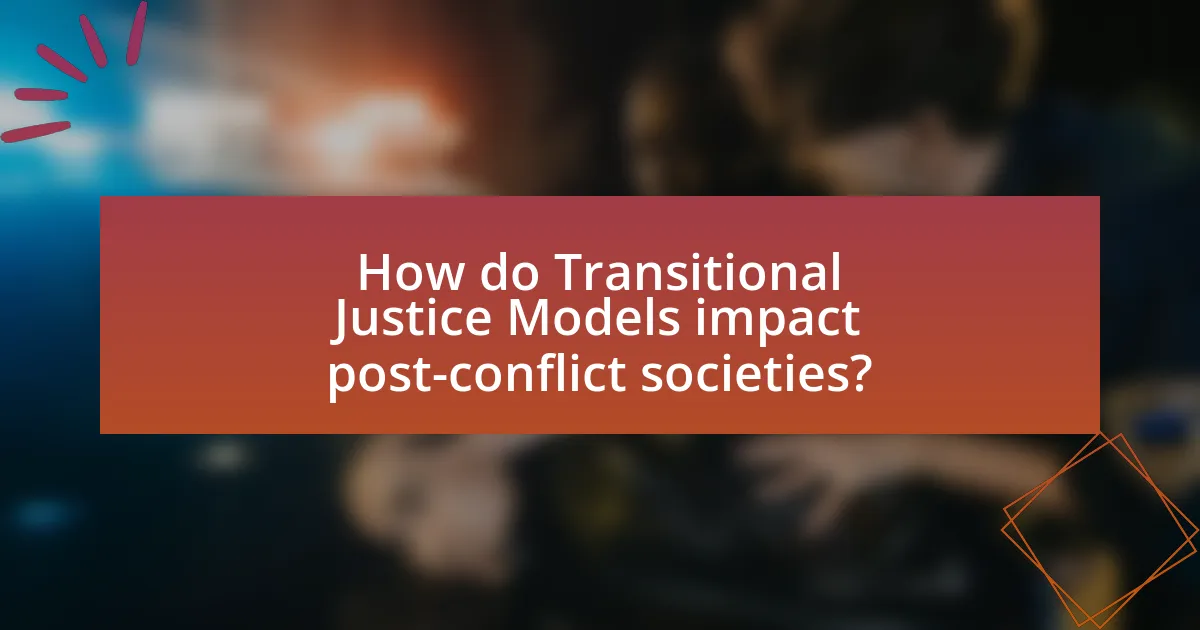
How do Transitional Justice Models impact post-conflict societies?
Transitional Justice Models significantly impact post-conflict societies by facilitating reconciliation, accountability, and the establishment of the rule of law. These models, which include truth commissions, reparations, and criminal prosecutions, aim to address past human rights violations and foster social cohesion. For instance, the Truth and Reconciliation Commission in South Africa played a crucial role in healing the nation post-apartheid by uncovering the truth about past atrocities and promoting forgiveness. Research indicates that societies implementing transitional justice mechanisms experience lower rates of recidivism in violence and improved trust in governmental institutions, as evidenced by studies conducted by the International Center for Transitional Justice.
What are the social implications of implementing Transitional Justice Models?
Implementing Transitional Justice Models has significant social implications, primarily aimed at fostering reconciliation and rebuilding trust in post-conflict societies. These models, which include truth commissions, reparations, and criminal prosecutions, can help address grievances from past injustices, thereby promoting social cohesion. For instance, the Truth and Reconciliation Commission in South Africa facilitated dialogue about apartheid-era atrocities, contributing to national healing and unity. Furthermore, research indicates that societies that engage in transitional justice processes often experience lower rates of recidivism in violence, as these models provide a platform for victims to voice their experiences and for perpetrators to acknowledge their actions. This acknowledgment can lead to a collective understanding of the past, which is crucial for preventing future conflicts.
How do these models affect community reconciliation?
Transitional justice models significantly influence community reconciliation by providing frameworks for addressing past injustices and fostering dialogue among affected groups. These models, such as truth commissions and reparations programs, facilitate acknowledgment of grievances, which is essential for healing and rebuilding trust within communities. For instance, the South African Truth and Reconciliation Commission, established post-apartheid, allowed victims to share their experiences, promoting collective understanding and forgiveness, which are crucial for reconciliation. Studies indicate that communities engaged in such processes report higher levels of social cohesion and reduced tensions, demonstrating the effectiveness of these models in promoting lasting peace and unity.
What role do Transitional Justice Models play in rebuilding trust in institutions?
Transitional Justice Models play a crucial role in rebuilding trust in institutions by addressing past injustices and promoting accountability. These models, which include truth commissions, reparations, and criminal prosecutions, facilitate a process of acknowledgment and redress that helps victims and communities heal. For instance, the Truth and Reconciliation Commission in South Africa successfully fostered dialogue and understanding between conflicting parties, which contributed to a more stable political environment and increased public confidence in governmental institutions. By ensuring that past abuses are recognized and addressed, Transitional Justice Models create a foundation for legitimacy and trust in the rule of law, ultimately enhancing the effectiveness and credibility of institutions in post-conflict societies.
What economic impacts can be observed from Transitional Justice Models?
Transitional Justice Models can lead to significant economic impacts, including the restoration of property rights and the promotion of economic stability. These models often facilitate reparations for victims, which can stimulate local economies by increasing purchasing power and fostering community development. For instance, the Truth and Reconciliation Commission in South Africa provided reparations that contributed to economic empowerment for marginalized communities, thereby enhancing local economic activities. Additionally, the establishment of rule of law through these models can attract foreign investment, as seen in post-conflict countries like Rwanda, where judicial reforms have led to improved economic growth rates.
How do these models influence economic recovery in post-conflict settings?
Transitional justice models significantly influence economic recovery in post-conflict settings by establishing legal frameworks that promote accountability and reconciliation. These models, such as truth commissions and reparations programs, help rebuild trust in institutions, which is essential for economic stability. For instance, the truth and reconciliation process in South Africa facilitated a smoother transition to democracy and economic recovery by addressing past injustices, thereby encouraging investment and economic participation. Additionally, reparations can provide financial support to victims, stimulating local economies and fostering social cohesion. Research indicates that countries implementing effective transitional justice measures experience faster economic recovery and improved governance, as seen in the cases of Rwanda and Sierra Leone, where post-conflict economic growth was linked to the establishment of justice mechanisms.
What are the long-term economic benefits of effective Transitional Justice?
Effective Transitional Justice can lead to long-term economic benefits such as enhanced stability, improved governance, and increased foreign investment. By addressing past injustices and fostering reconciliation, societies can create a more stable environment conducive to economic growth. For instance, countries like South Africa, which implemented a Truth and Reconciliation Commission, experienced a boost in investor confidence, leading to economic recovery and growth post-apartheid. Additionally, effective Transitional Justice can reduce the likelihood of future conflicts, which historically disrupt economies; the World Bank has noted that countries with successful transitional processes tend to have better economic performance indicators over time.
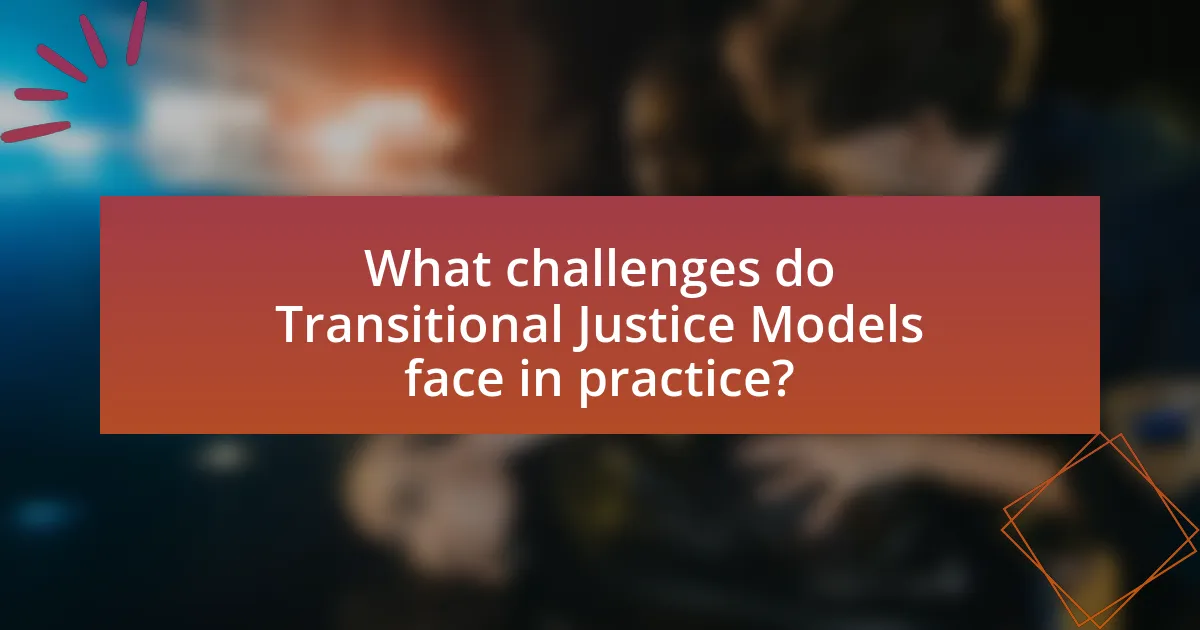
What challenges do Transitional Justice Models face in practice?
Transitional Justice Models face significant challenges in practice, including political resistance, lack of resources, and societal divisions. Political resistance often arises from those in power who may fear accountability for past actions, undermining the implementation of justice mechanisms. For instance, in countries like Syria and Venezuela, government opposition has stalled transitional justice processes. Additionally, a lack of financial and human resources can hinder the establishment of effective institutions, as seen in post-genocide Rwanda, where the Gacaca courts faced operational limitations. Societal divisions, often exacerbated by historical grievances, can lead to mistrust in the justice process, as observed in South Africa, where the Truth and Reconciliation Commission struggled to unify a deeply divided society. These challenges collectively impede the effectiveness of Transitional Justice Models in achieving their goals of accountability, reconciliation, and healing.
What are the common obstacles to implementing Transitional Justice Models?
Common obstacles to implementing Transitional Justice Models include political resistance, lack of resources, and societal divisions. Political resistance often arises from those in power who fear accountability for past actions, as seen in countries like Sudan, where leaders have obstructed justice efforts. Lack of resources can hinder the establishment of necessary institutions, as evidenced in post-conflict societies like Liberia, where financial constraints limited the effectiveness of truth commissions. Societal divisions, often exacerbated by ethnic or political tensions, can impede consensus on justice processes, as observed in Rwanda, where differing narratives about the genocide complicate reconciliation efforts.
How do political dynamics affect the success of these models?
Political dynamics significantly influence the success of transitional justice models in post-conflict societies by shaping the political will and institutional capacity necessary for implementation. For instance, in countries like South Africa, the political commitment to reconciliation and justice facilitated the success of the Truth and Reconciliation Commission, which was supported by the ruling party’s desire to foster national unity after apartheid. Conversely, in contexts where political factions resist accountability, such as in Syria, the lack of political will undermines transitional justice efforts, leading to stalled processes and continued impunity. This correlation between political dynamics and transitional justice outcomes is evident in various case studies, demonstrating that the alignment of political interests with justice initiatives is crucial for their effectiveness.
What role does public perception play in the effectiveness of Transitional Justice?
Public perception significantly influences the effectiveness of Transitional Justice by shaping the legitimacy and acceptance of justice mechanisms. When the public perceives Transitional Justice initiatives as fair and credible, it fosters trust in the processes, which is essential for their success. For instance, in South Africa, the Truth and Reconciliation Commission gained public support due to its transparent approach, which helped in reconciling a divided society post-apartheid. Conversely, in countries where public perception is negative, such as in some Latin American states, skepticism towards judicial processes can undermine efforts, leading to a lack of cooperation and engagement from the community. Thus, public perception acts as a critical determinant in the overall impact and sustainability of Transitional Justice initiatives.
How can Transitional Justice Models be improved?
Transitional Justice Models can be improved by enhancing community participation in the design and implementation processes. Research indicates that inclusive approaches, which actively involve affected communities, lead to more effective and accepted outcomes. For instance, the International Center for Transitional Justice highlights that when local voices are integrated, the legitimacy and sustainability of justice initiatives increase, as seen in the successful reconciliation efforts in South Africa post-apartheid. Additionally, incorporating restorative justice principles can foster healing and address the needs of victims more comprehensively, as evidenced by the Truth and Reconciliation Commission’s impact in Canada regarding Indigenous peoples.
What best practices can enhance the effectiveness of these models?
Best practices that can enhance the effectiveness of transitional justice models in post-conflict societies include ensuring local community involvement, integrating restorative justice principles, and maintaining transparency throughout the process. Local community involvement fosters ownership and relevance, as evidenced by the success of community-based reconciliation initiatives in Rwanda, which significantly contributed to social cohesion post-genocide. Integrating restorative justice principles, such as victim-offender mediation, has been shown to reduce recidivism rates and promote healing, as highlighted in studies conducted by the United Nations Office on Drugs and Crime. Transparency in proceedings builds trust and legitimacy, which is crucial for the acceptance of transitional justice measures, as demonstrated by the Truth and Reconciliation Commission in South Africa, where public hearings increased accountability and societal engagement.
How can stakeholder engagement be optimized in Transitional Justice processes?
Stakeholder engagement in Transitional Justice processes can be optimized by implementing inclusive dialogue mechanisms that ensure diverse representation and active participation. This approach fosters trust and collaboration among affected communities, government entities, and civil society organizations. For instance, the Truth and Reconciliation Commission in South Africa effectively engaged stakeholders through public hearings, allowing victims and perpetrators to share their experiences, which enhanced community involvement and ownership of the process. Research indicates that inclusive stakeholder engagement leads to more sustainable outcomes in post-conflict societies, as it addresses grievances and promotes healing.
What practical steps can be taken to implement effective Transitional Justice Models?
To implement effective Transitional Justice Models, it is essential to establish a comprehensive framework that includes truth commissions, reparations, and judicial accountability. Truth commissions, such as the South African Truth and Reconciliation Commission, facilitate public acknowledgment of past atrocities, fostering societal healing. Reparations programs, like those in Colombia, provide financial and social support to victims, addressing their needs and restoring dignity. Judicial accountability, exemplified by the International Criminal Court, ensures that perpetrators of serious crimes are prosecuted, reinforcing the rule of law. These steps collectively contribute to rebuilding trust in institutions and promoting long-term peace in post-conflict societies.

